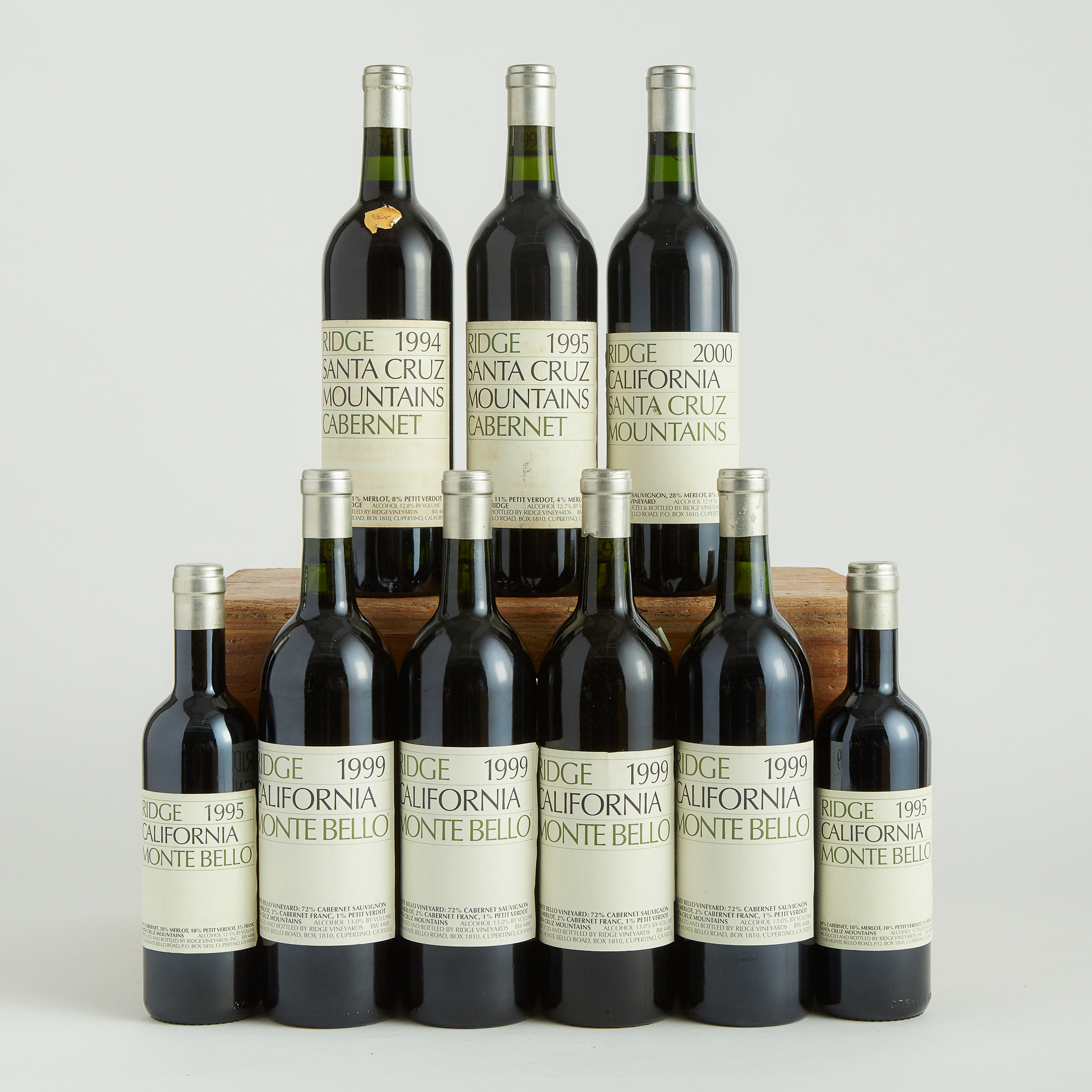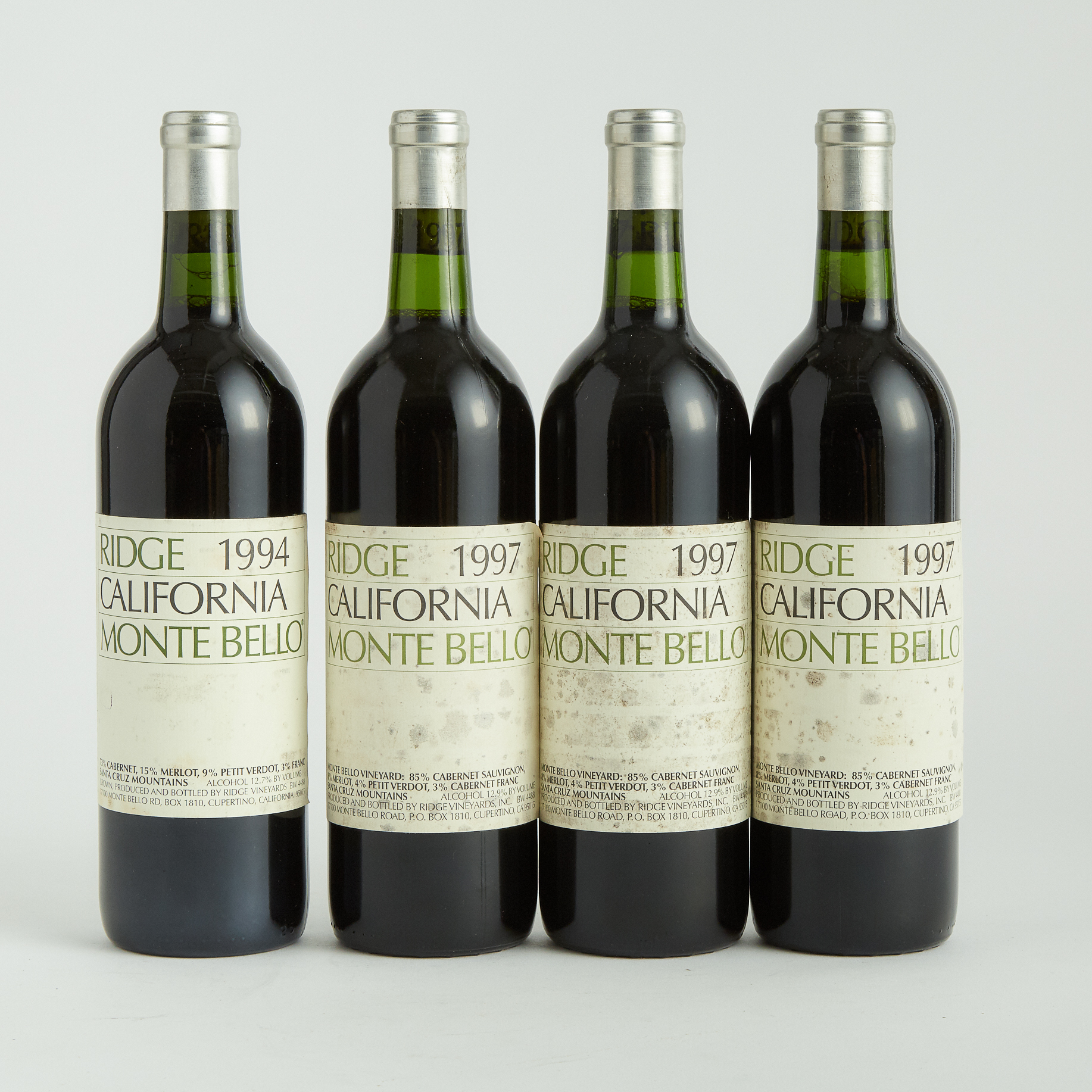Ridge Vineyards, Monte Bello, Cabernet Sauvignon--Vintage 1963
3 bottles per lot
AN INCREDIBLE AND UNIQUE RETROSPECTIVE OF RIDGE'S VITICULTURAL HISTORY EXPLORING BOTH ESTABLISHED VINEYARDS AND EXPERIMENTAL WINES Ridge Vineyards has been at the top of California winemaking for over a century. Situated high atop the northern reaches of the Santa Cruz Mountains, it has produced distinctive, rich, and refined Cabernets from its Monte Bello Vineyard; as well as led the way in diversifying grape production in the whole of California. The estate is located between 1,300ft and 2,660ft on decomposing Franciscan rock and fissured limestone, which is usually common in France, but rare in California. Overlooking the San Francisco peninsula, the proximity to the Pacific Ocean provides for many damp, foggy mornings, and breezy afternoons, which allow the grapes to ripen slowly and evenly. The cool, mountainous climate combined with a south/south-easterly exposure yield ideal surroundings for producing world-class wines. Ridge, Monte Bello Monte Bello has been the site of many generations of wine production. Though the equipment used today is remarkably modern in contrast to a simple crushing device of the old days, Ridge continues to rely heavily on the traditional winemaking methods of past generations. The Monte Bello vineyard was planted, and the winery constructed, in 1886 with its first vintage produced in 1892. It was left abandoned during the years of Prohibition until 1949, when 8-acres of Cabernet were replanted. A group of Stanford University graduates headed by Dave Bennion resurrected the vineyard in 1959, and used those original vines for the first Monte Bello vintage in 1962. (The second vintage of 1963 is represented here.) Production started slowly, consisting mostly of Cabernet Sauvignon and several Zinfandels, until the owners turned the winery from a weekend hobby into a real business. However, it wasn't until the arrival of fellow Stanford graduate and winemaker Paul Draper in 1969 that Ridge's natural recognition took off. Draper combined his philosophy education and experiences in Chile and Château Latour to counter the usually formulaic approach to making wine. He insists that the wine, a blend of Cabernet, Merlot and Petit Verdot, is typical of the vineyard. "There is no recipe for making it," he says. "Maybe one per cent of the world's wine is truly a product of the soil, of the vineyard. In those wines, the vineyard creates the character. That's what I am striving for and the creation of small lots from within a single vineyard is absolutely essential. It keeps all options open. If everything is dumped in a huge tank, you lose the chance of making a great wine. I'm simply selecting what the vineyard offers and making a call on the selected lots to achieve the best character. Nature is doing the creating." Draper has credited the wine's quality to its maturity, the natural yeasts in the vineyard, and the fact that Ridge does very little with the filtration process. Vines are head-trained and cane-pruned on trellis with no irrigation except for the fledgling vines. Today, there are 66.4 acres of Cabernet Sauvignon between 10- and 52-years old, 12.8-acres of Merlot between 6- and 33-years old, 2.2 acres of Petit Verdot between 10- and 13-years old and 1.3-acres of 31-year old Cabernet Franc. Approximately 8,000 cases of the 60,000 produced each year are the famous Cabernet Sauvignon. The 1970s and the birth of new vineyard sites. The Advance Tasting Program (ATP), established by Ridge in 1978, is a logical extension of Ridge's long-standing dedication to single vineyard winemaking. Ridge's interest in individual sites, regardless of size, has led them to produce some wines in quantities ranging from 5 to 55 barrels. Since 1978, these have been made available through the ATP to a limited group of connoisseurs who have been able to follow the expertimental foresight of Paul Draper and his winemaking team. Some of these "cuvées" have found their way into Ridge's mainstream production. This
Ridge Vineyards, Monte Bello, Cabernet Sauvignon--Vintage 1963
3 bottles per lot
AN INCREDIBLE AND UNIQUE RETROSPECTIVE OF RIDGE'S VITICULTURAL HISTORY EXPLORING BOTH ESTABLISHED VINEYARDS AND EXPERIMENTAL WINES Ridge Vineyards has been at the top of California winemaking for over a century. Situated high atop the northern reaches of the Santa Cruz Mountains, it has produced distinctive, rich, and refined Cabernets from its Monte Bello Vineyard; as well as led the way in diversifying grape production in the whole of California. The estate is located between 1,300ft and 2,660ft on decomposing Franciscan rock and fissured limestone, which is usually common in France, but rare in California. Overlooking the San Francisco peninsula, the proximity to the Pacific Ocean provides for many damp, foggy mornings, and breezy afternoons, which allow the grapes to ripen slowly and evenly. The cool, mountainous climate combined with a south/south-easterly exposure yield ideal surroundings for producing world-class wines. Ridge, Monte Bello Monte Bello has been the site of many generations of wine production. Though the equipment used today is remarkably modern in contrast to a simple crushing device of the old days, Ridge continues to rely heavily on the traditional winemaking methods of past generations. The Monte Bello vineyard was planted, and the winery constructed, in 1886 with its first vintage produced in 1892. It was left abandoned during the years of Prohibition until 1949, when 8-acres of Cabernet were replanted. A group of Stanford University graduates headed by Dave Bennion resurrected the vineyard in 1959, and used those original vines for the first Monte Bello vintage in 1962. (The second vintage of 1963 is represented here.) Production started slowly, consisting mostly of Cabernet Sauvignon and several Zinfandels, until the owners turned the winery from a weekend hobby into a real business. However, it wasn't until the arrival of fellow Stanford graduate and winemaker Paul Draper in 1969 that Ridge's natural recognition took off. Draper combined his philosophy education and experiences in Chile and Château Latour to counter the usually formulaic approach to making wine. He insists that the wine, a blend of Cabernet, Merlot and Petit Verdot, is typical of the vineyard. "There is no recipe for making it," he says. "Maybe one per cent of the world's wine is truly a product of the soil, of the vineyard. In those wines, the vineyard creates the character. That's what I am striving for and the creation of small lots from within a single vineyard is absolutely essential. It keeps all options open. If everything is dumped in a huge tank, you lose the chance of making a great wine. I'm simply selecting what the vineyard offers and making a call on the selected lots to achieve the best character. Nature is doing the creating." Draper has credited the wine's quality to its maturity, the natural yeasts in the vineyard, and the fact that Ridge does very little with the filtration process. Vines are head-trained and cane-pruned on trellis with no irrigation except for the fledgling vines. Today, there are 66.4 acres of Cabernet Sauvignon between 10- and 52-years old, 12.8-acres of Merlot between 6- and 33-years old, 2.2 acres of Petit Verdot between 10- and 13-years old and 1.3-acres of 31-year old Cabernet Franc. Approximately 8,000 cases of the 60,000 produced each year are the famous Cabernet Sauvignon. The 1970s and the birth of new vineyard sites. The Advance Tasting Program (ATP), established by Ridge in 1978, is a logical extension of Ridge's long-standing dedication to single vineyard winemaking. Ridge's interest in individual sites, regardless of size, has led them to produce some wines in quantities ranging from 5 to 55 barrels. Since 1978, these have been made available through the ATP to a limited group of connoisseurs who have been able to follow the expertimental foresight of Paul Draper and his winemaking team. Some of these "cuvées" have found their way into Ridge's mainstream production. This















Testen Sie LotSearch und seine Premium-Features 7 Tage - ohne Kosten!
Lassen Sie sich automatisch über neue Objekte in kommenden Auktionen benachrichtigen.
Suchauftrag anlegen